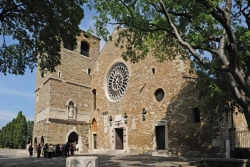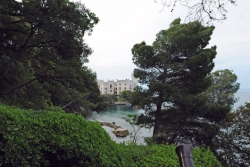Trieste
Trieste, Italy's City of Mystery and Romance
In the late 1940s, Europe couldn't quite decide what to do with
Trieste. Was it a Slavic outpost of Italy, or a Latin addition to
Eastern Europe? For a while it could have gone either way, before
the city came under Italian jurisdiction in 1954.
Trieste still has a slightly stateless feel to it. There is a
sense that it could be in Croatia or Slovenia and its citizens
speaking Slovenian or Serbo-Croat if it were not for the caprices
of history. It is an Italian city with an Adriatic rather than a
Mediterranean sensibility. Many of its citizens are Slavs.
The name of the city is just one spare letter away from the
Italian word for sad, and there is a moody melancholy that descends
on the place in the winter, a quality that attracted the writer
James Joyce.
Joyce is an honorary local with a statue that makes him seem
positively cheery. He wrote The Dubliners  and A Portrait of the Artist as a Young
Man
and A Portrait of the Artist as a Young
Man in the Caffe Pirona. It
is still there on the Largo Barriera Vecchia, with the delicious
chocolate pastries a daunting obstacle to any would-be writer
trying to concentrate on creating a new literary classic.
in the Caffe Pirona. It
is still there on the Largo Barriera Vecchia, with the delicious
chocolate pastries a daunting obstacle to any would-be writer
trying to concentrate on creating a new literary classic.
The coffee-houses are Trieste's proudest feature, a legacy of
the Austro-Hungarian Empire era, and oozing 19th century
style. One of the finest is the Caffe San Marco on Via Cesare
Battisti, with Venetian murals offering a touch of antique class,
while the polished chrome of the coffee machines testify that the
Italians devote as much of their engineering genius to creating a
proper espresso as they do to fine-tuning a Ferrari.

Cathedral San Giusto, Trieste
The tourist sights in Trieste range from the sublime to the
ridiculous. The glories lie in the San Giusto cathedral, an
underrated example of a provincial basilica, with some graceful
mosaics dating from the 11th century. The lines of the
cathedral have an Eastern feel, redolent of Byzantine or Orthodox
churches.
By contrast, the fascist war memorial is constructed in the
bombastic, neo-classical style associated with Mussolini. The
municipal buildings have a similar ugly self-importance, but that
can be solved with a quick about-turn, for views over the Adriatic,
with liners coasting down towards the Croatian beach resorts.
Those expecting to dine on anti-pasti and delicate Italian pasta
dishes may be surprised by Trieste's restaurant scene. Many locals
seem to prefer to gnaw on a ham bone and pile up mounds of
sauerkraut on their plates, perhaps another legacy of Austrian
rule.
Trieste cuisine, the Cucina Triestina, blends Italian,
Slavic and German influences. Gnocchi with cheese and ham
are close cousins of Eastern Europe's dumpling dishes, and the
local specialty, stinco, is a baked veal or pork hock that
would be perfectly at home in any German bierkeller.
In fact there is no shortage of bierkellers in Trieste. The
Friuli-Venezia wines are perfectly quaffable, but beer is the drink
of choice in the city. There's a massive choice at the Forst
Birreria on Via Galatti, which attracts a crowd that covers all
age-groups.

Castello di Miramare
In summer, Trieste cheers up, and everybody heads up the coast
to Miramare. It's one of those romantic 19th century
castles that seems to have been built from a Disney sketch. Its
gardens are the highlight, with romantic trails meandering through
woods and around the Adriatic coast.
Among the castle's past residents were Maximilian, Emperor of
Mexico, and Archduke Franz Ferdinand. Both met unhappy ends, but
then that air of lurking sadness is part of Trieste's character.
It's a city of history, mystery and intrigue, caught at the
crossroads of contrasting cultures.